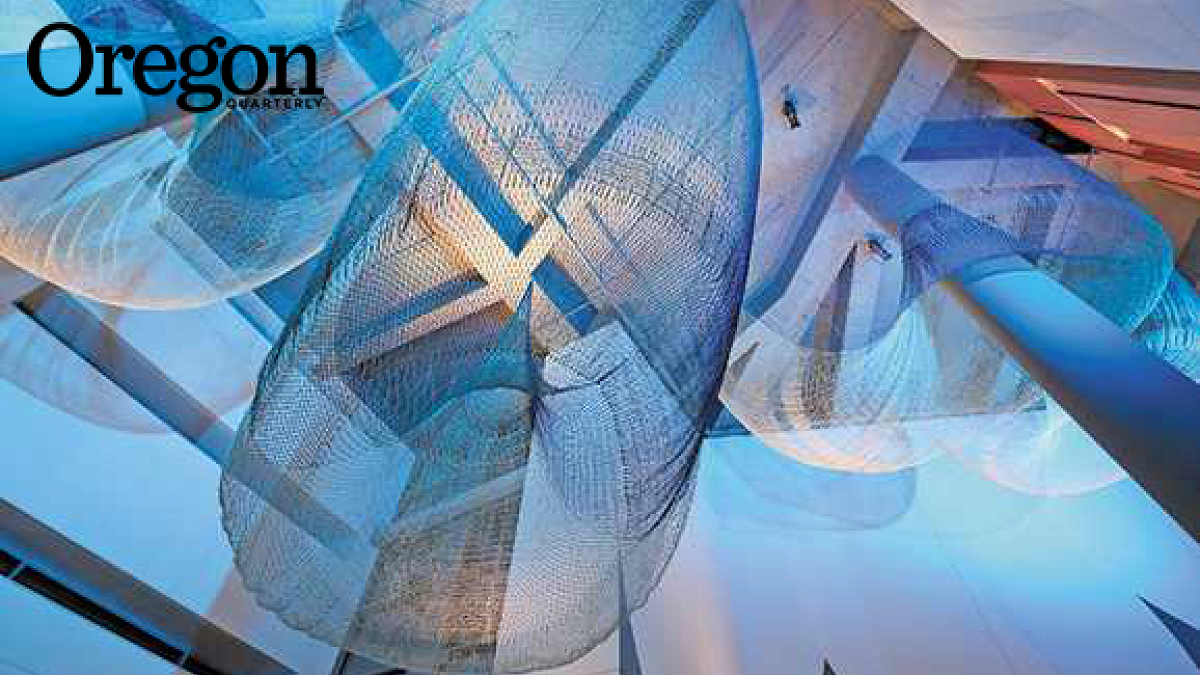“We get only a flickering glimpse of reality,” Plato wrote 2,000 years ago in a famous passage now called the Allegory of the Cave. “The images we see are like the shadows of moving figures cast by a fire onto the back wall of a cave.”
An interesting idea, for sure, but who would expect to find an evocation of that philosophy in a sports arena? But here it is, high overhead in the University of Oregon’s Matthew Knight Arena, a splendid sculpture by world-renowned artist Janet Echelman. The name of the sculpture? Allegory.
Echelman uses wind, light, and cord to create living, breathing “sculpture environments.” Travelers in North America might know her Water Sky Garden, which premiered at the 2010 Vancouver Winter Olympics, or Her Secret Is Patience, a billowing circular form that spans two city blocks in Phoenix. In Singapore and Sydney, Amsterdam and Stuttgart, her sculptures enliven community life around the world. And now, Eugene.
What you first see as you enter the northeast curve of the arena are huge, circular nets billowing overhead. Green, white, blue; they encircle space the way a seine encircles herring, the way a spiral galaxy encircles stars, the way the sweeping arms of a giant Douglas fir gather the sky. But as you move through the hallway, the nets themselves seem to disappear, replaced by shadows they throw onto the wall. Then the glimpse of the shadows fades, and again, there are the nets themselves wafting toward the ceiling high above.
On a fall afternoon just before Allegory was to be presented to the public, Echelman stood in the arena hallway, studying the installation. A small, lively woman dressed in black, she punched numbers into her cell phone to communicate with her lighting engineer in Boston, making sure the lights were exactly as she intended. Close collaboration with a lighting engineer is critical in a sculpture that is as much made of light and shadow as it is of cord. “A sculpture should be thrilling to look at,” she said. “But a lasting sculpture has to be more than that. It has to hint at some connections that we don’t entirely understand.”
True to her vision, there is no point of view from which an observer can see all of the sculpture at once. While the nets and knots are three-dimensional, what you see on the wall is flat and devoid of color. On the other hand, maybe the nets and knots are four dimensional, because they change color over time, as Ducks fans walk through the arena’s hall, triggering sensors that alter the lights that illuminate the nets and knots.
And what is that reality that we glimpse only dimly in Plato’s flickering light? “We can’t know,” Plato believed. “That is the necessary imperfection of human perception.” But it’s fun to speculate.
“People might think of the interconnectedness of the game,” Echelman muses. “The trajectory of the basketball weaves nets that connect the five players on the floor, who are knitted into patterns of family and fans.” Alternatively, here in the great forests of Oregon—suggested both in the pattern of the arena’s hardwood floors and in the upsweeping nets of the sculpture—observers may think of the interconnectedness of the ecosystems that sustain us, the great branching webs of life.
The weekend before Echelman came to Eugene for the opening of Allegory, she visited the H. J. Andrews Experimental Forest at the headwaters of the McKenzie River. On ropes, she ascended 130 feet up a 500-year-old Douglas fir tree. There, in low evening light cast through the ancient, tangled, mist- and moss-shrouded boughs, she could see the shadows of the nets and knots of the forest ecosystem, folded and draped over the encircling hills.
“When developing an idea,” Echelman said, “I envision the ideal manifestation of the idea”—a method that would bring a smile of recognition to Plato’s old marble face. “I try to imagine my goal as a reality, and then work backwards to figure out all the steps I need to make it so. We all have the potential to do that,” she insists, “but it’s a skill that takes practice.”
These are words that the UO’s students and student-athletes can take to heart. It’s not only a sculpture that is taking shape in the university’s arena, but the dreams and aspirations of generations of young people, who will envision an ideal and then work to make it real.
More about Janet Echelman’s sculptures and artistic philosophy can be found at www.echelman.com.
—By Kathleen Dean Moore
Kathleen Dean Moore is distinguished professor emerita of philosophy at Oregon State University.


